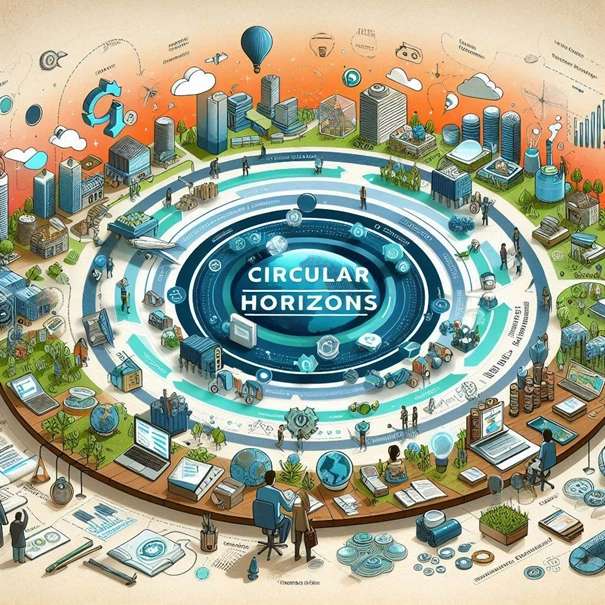Circular Horizons - Exploring Sustainable Business Models

Knowledge
- Understanding of several circular economy business models, including product-as-a-service, sharing platforms, and remanufacturing.
- Awareness of the principles and benefits of circular economy practices in promoting sustainability and resource efficiency.
Skills
- Ability to analyze and evaluate different circular economy business models in terms of their environmental impact, economic viability, and societal benefits.
- Competence in identifying opportunities and challenges associated with implementing circular economy practices in diverse industries.
Responsibility & Autonomy
- Taking responsibility for promoting circular economy principles within business operations and decision-making processes.
- Exercising autonomy in proposing innovative solutions and strategies to transition towards circular business models.
Welcome to "Circular Horizons"! As businesses move towards sustainability, adopting circular economy principles is becoming crucial. This WebQuest will introduce you to various circular economy business models and their potential to transform industries for a sustainable future.
Imagine you are part of a team exploring innovative business strategies that promote sustainability. You will engage in experiential learning activities that involve real-world examples, interactions with industry experts, and practical simulations. These experiences will help you develop actionable insights and strategies for implementing circular economy practices.
As a sustainability consultant, your task is to research, evaluate, and propose methods for implementing circular economy business models within a chosen sector or company. You will create a detailed proposal that outlines how these models can enhance resource efficiency and sustainability. Finally, you will present your recommendations to a panel of stakeholders involved in advancing circular economy principles.
1.Explore Circular Economy Concepts
University Resources: Visit your university’s sustainability office or administration to learn about their current practices and suppliers. Use this as a real-world example of circular practices.
2. Research
- Investigate circular economy principles and business models through academic articles, industry reports, and credible websites. Focus on models like product-as-a-service, sharing platforms, and remanufacturing.
- Analyze Circular Economy Business Models
- Living Lab Interaction: Use case studies from companies participating in university partnerships or local business networks to understand successful circular economy models.
- Engage with Stakeholders: Reach out to local businesses or university departments that have implemented circular economy practices to discuss their experiences and insights.
3. Evaluation
- Assess the advantages and disadvantages of various circular economy models in terms of resource use, waste reduction, and customer value.
- Practical Simulations: Participate in simulations or role-play exercises to explore how circular business models might function in real-world scenarios.
4. Application
- Focus on one industry or sector and identify feasible ways to implement circular economy principles. Consider the implications for manufacturing, retail, or technology sectors.
- Create a Circular Economy Plan
5. Develop Your Plan
- Introduction: Outline the industry or company and its current practices.
- Objectives: Define goals such as reducing waste or improving resource efficiency.
- Strategies: Propose circular economy practices such as recycling, leasing models, or resource-sharing.
- Implementation Plan: Provide a timeline and action plan, including key milestones and responsible parties.
- Expected Results: Highlight the anticipated benefits for the company, stakeholders, and the environment.
- Prepare and Present
6. Presentation Preparation:
- Create a compelling PowerPoint or video presentation summarizing your proposal. Use visuals, charts, and data to support your recommendations.
- Practice delivering your presentation to effectively communicate the benefits of circular economy practices.
- Living Lab Interaction: Present your proposal to a panel consisting of faculty members, local business leaders, or sustainability experts. Be prepared to answer questions and discuss your research and recommendations.
- Ellen MacArthur Foundation
- Circular economy action plan - European Commission
- Green Deal: Circular Economy Action Plan – Policies - IEA
- Circularity beyond sustainability: circular business models drive resilient growth | FT Moral Money
- What If We Don’t Buy Products and We Buy Service? Circular Economy Explained | Animated Video Essay
- Products as a Service
- Remanufacturing: i vantaggi e il potenziale circolare
- Product-as-a-Service (PaaS) - Circularity
- Circular Economy - What is Remanufacturing?
- CIRCULAR ECONOMY: Sharing Platforms as a Business Model
Through this WebQuest, you have gained valuable insights into the diverse range of circular economy business models and their potential to drive sustainability and resource efficiency. By developing strategies for implementing circular economy practices, you can contribute to building a more resilient and environmentally conscious economy. Reflect on your learning experience and consider how you can apply these principles to promote circularity in your future endeavors.
- Circular Economy Portugal, CEP promotes the transition to a circular economy in Portugal, Website
- The EIB Circular Economy Guide, European Investment Bank, 2020, report
- COMMUNICATION FROM THE COMMISSION TO THE EUROPEAN PARLIAMENT, THE COUNCIL, THE EUROPEAN ECONOMIC AND SOCIAL COMMITTEE AND THE COMMITTEE OF THE REGIONS - A new Circular Economy Action Plan For a cleaner and more competitive Europe
- The European Green Deal A growth strategy that protects the climate
- Family Circlem EU project on circular economy
- FamilyFootprints, EU project on circular economy
Interface's Mission Zero
Interface, a global carpet manufacturer, embarked on a journey called "Mission Zero" to eliminate any negative impact it has on the environment by 2020. This initiative is a prime example of a successful circular economy strategy.
Key Features of Interface's Mission Zero:
Closed-Loop Manufacturing: Interface pioneered processes to recycle used carpet materials into new products, reducing waste and conserving resources.
Product-as-a-Service Model: Introduced leasing options where customers lease carpets rather than buying them outright, promoting product longevity and material reuse.
Stakeholder Collaboration: Engaged with suppliers and customers to create a sustainable supply chain and increase awareness about environmental impacts.
Benefits:
Achieved significant reductions in greenhouse gas emissions, water consumption, and waste to landfill.
Enhanced brand reputation and customer loyalty through sustainable practices.
Generated cost savings through resource efficiency and waste reduction.
Studying Interface's Mission Zero can provide valuable insights into how circular economy principles can be effectively applied in manufacturing and inspire innovative solutions for sustainable business practices.
Link: https://www.interface.com/US/en-US/sustainability/our-mission.html
